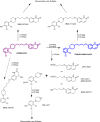Classics in Chemical Neuroscience: Aripiprazole
- PMID: 28368577
- PMCID: PMC5495458
- DOI: 10.1021/acschemneuro.7b00087
Classics in Chemical Neuroscience: Aripiprazole
Abstract
Aripiprazole was the first antipsychotic developed to possess agonist properties at dopamine D2 autoreceptors, a groundbreaking strategy that presented a new vista for schizophrenia drug discovery. The dopamine D2 receptor is the crucial target of all extant antipsychotics, and all developed prior to aripiprazole were D2 receptor antagonists. Extensive blockade of these receptors, however, typically produces extrapyramidal (movement) side effects, which plagued first-generation antipsychotics, such as haloperidol. Second-generation antipsychotics, such as clozapine, with unique polypharmacology and D2 receptor binding kinetics, have significantly lower risk of movement side effects but can cause myriad additional ones, such as severe weight gain and metabolic dysfunction. Aripiprazole's polypharmacology, characterized by its unique agonist activity at dopamine D2 and D3 and serotonin 5-HT1A receptors, as well as antagonist activity at serotonin 5-HT2A receptors, translates to successful reduction of positive, negative, and cognitive symptoms of schizophrenia, while also mitigating risk of weight gain and movement side effects. New observations, however, link aripiprazole to compulsive behaviors in a small group of patients, an unusual side effect for antipsychotics. In this review, we discuss the chemical synthesis, pharmacology, pharmacogenomics, drug metabolism, and adverse events of aripiprazole, and we present a current understanding of aripiprazole's neurotherapeutic mechanisms, as well as the history and importance of aripiprazole to neuroscience.
Keywords: 5-HT1A; 5-HT2A; 5-HT2B; Aripiprazole; D2; dopamine; receptors; schizophrenia; serotonin.
Figures




References
-
- Perala J, Suvisaari J, Saarni SI, Kuoppasalmi K, Isometsa E, Pirkola S, Partonen T, Tuulio-Henriksson A, Hintikka J, Kieseppa T, Harkanen T, Koskinen S, Lonnqvist J. Lifetime prevalence of psychotic and bipolar I disorders in a general population. Arch Gen Psychiatry. 2007;64(1):19–28. - PubMed
-
- Abi-Dargham A, Gil R, Krystal J, Baldwin RM, Seibyl JP, Bowers M, van Dyck CH, Charney DS, Innis RB, Laruelle M. Increased striatal dopamine transmission in schizophrenia: confirmation in a second cohort. Am J Psychiatry. 1998;155(6):761–7. - PubMed
-
- Carlsson A. Does dopamine have a role in schizophrenia? Biol Psychiatry. 1978;13(1):3–21. - PubMed
Publication types
MeSH terms
Substances
Grants and funding
LinkOut - more resources
Full Text Sources
Other Literature Sources
Research Materials

